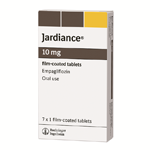For years, diabetes drugmakers have been revving up new drugs to continue fueling sales as older meds go off patent. Over the past couple, they've felt the pain of U.S. payer pressure perhaps more than rivals in any other drug category.
 |
| Bernstein analyst Ronny Gal |
Put the two together, and you have drug launches that are slower, and might not pay off in the long run as much as their makers had hoped--even when the new meds truly are new and better than older alternatives.
Bernstein analyst Ronny Gal thinks Novo Nordisk's ($NVO) Xultophy might avoid that collision. A fixed-dose combo of its new-to-the-U.S. insulin Tresiba and its GLP-1 blockbuster Victoza, Xultophy isn't simply a convenience-oriented duo product as combo meds often are. Xultophy "nicely balanced the side effects of two drugs," Gal says, which allowed researchers to step up dosages safely in treat-to-target trials.
Plus, the drug's payoff in clinical trials was impressive--"a bit of 'shock and awe' in the absolute impact of Xultophy on patients who started on the drug after oral therapy," Gal says, citing close to 2% benefit in HbA1c, a barometer of blood sugar management.
Xultophy is expensive, Gal notes, partly because it contains Victoza, which runs $18 per day versus $7 to $9 for insulin, and partly because it enables stepped-up doses. Payers are likely to set up some hurdles to that by limiting it to patients who are more obese or who have higher CV risks, he says.
Still, Xultophy is likely to beat Sanofi's ($SNY) combo med LixiLan at efficacy, he predicts, though the drug's actual details aren't public yet. There's a risk that the French drugmaker might create pricing competition by offering the combo at a small premium to one of its elements, Lantus, to help shore up that fading franchise.
 Plus, though Gal doesn't explicitly mention it, there could be good reason for doctors to look at CV status when deciding whether to prescribe Xultophy--and for payers to consider it. Earlier this month, Novo unveiled top-line data from Victoza's cardiovascular safety trial, and it not only proved safe, but offered some actual benefits. That was the hoped-for result--particularly after Eli Lilly ($LLY) and Boehringer Ingelheim's Jardiance offered up CV benefits in its trial.
Plus, though Gal doesn't explicitly mention it, there could be good reason for doctors to look at CV status when deciding whether to prescribe Xultophy--and for payers to consider it. Earlier this month, Novo unveiled top-line data from Victoza's cardiovascular safety trial, and it not only proved safe, but offered some actual benefits. That was the hoped-for result--particularly after Eli Lilly ($LLY) and Boehringer Ingelheim's Jardiance offered up CV benefits in its trial.
But success certainly wasn't guaranteed, as Novo acknowledged--and Sanofi knows firsthand. Sanofi's GLP-1 Lyxumia posted CV data showing it didn't increase heart risks, but didn't lower them either. Full data from the Victoza CV trial will be available later this year.
Bottom line: Bernstein now estimates 2020 sales for Xultophy of 10 billion Danish kronor, or about $1.4 billion, twice as much as the firm figured before--as high as $1.7 billion if all goes well.
Good news for the drug, not so good for its rivals--potentially including Victoza and Tresiba themselves--because Bernstein sees the combo cannibalizing other basal insulins and GLP-1s. And though Xultophy might avoid the head-on impact of payer pressure on its debut, it's likely to feel something of a hit.
Xultophy "offers Novo the opportunity to capture share from other players in the market and thus to outperform its diabetes peers," Gal says. "The challenge is that the overall diabetes market is softening and thus the achievement is less impactful."
Novo hopes to launch the combo med in the U.S. in the third quarter.
Special Report: Top 10 best-selling diabetes drugs of 2013